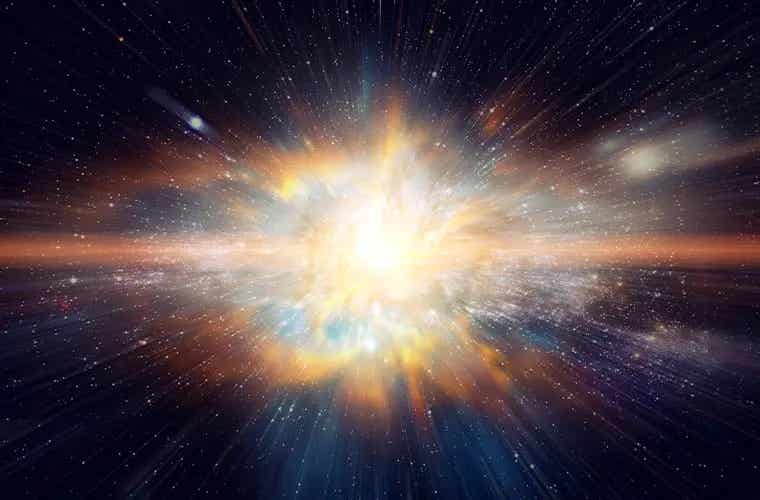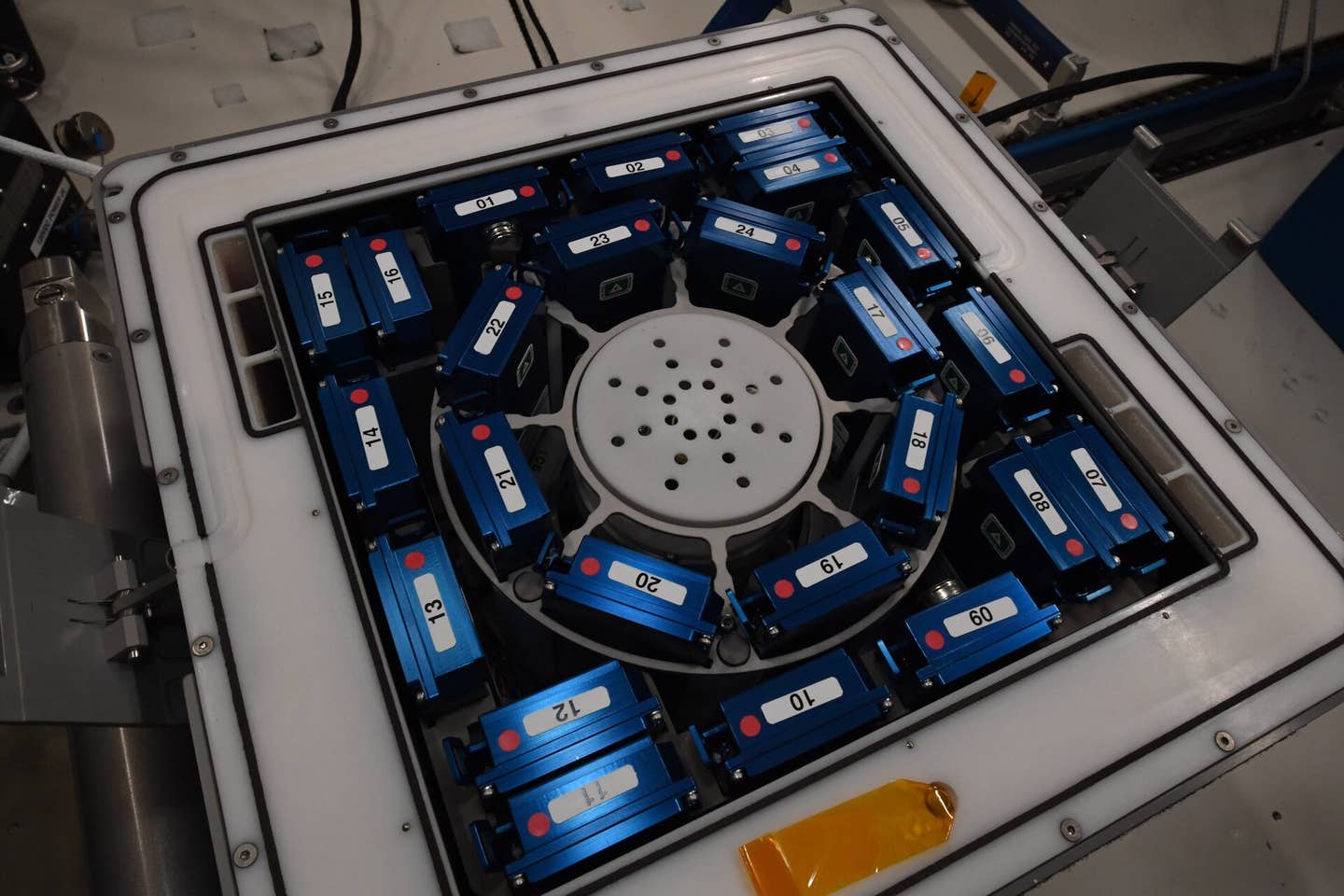Dark matter may end our universe in a ‘Big Crunch’
New study suggests dark energy could reverse, causing the universe to collapse in a “Big Crunch” 20 billion years from now.

A new study challenges the idea of an ever-expanding universe. (CREDIT: CC BY-SA 4.0)
Astrophysicists have presumed for nearly a century that the universe will just keep expanding for all eternity, driven by an invisible force called dark energy. But new data suggest that this is unlikely to occur. The universe will ultimately cease to expand and collapse in a fiery collapse called the "Big Crunch," say physicists Hoang Nhan Luu, Yu-Cheng Qiu, and S.-H. Henry Tye.
Their study merges data from Chile's Dark Energy Survey (DES) with Arizona's Dark Energy Spectroscopic Instrument (DESI). The two scopes, together, track the distribution of how galaxies are spread out throughout the universe and how fast they're moving away from one another.
Tye, a physicist at Cornell, said the finding goes against a 20-year-old cosmological assumption: that dark energy, or the cosmological constant, is positive and permanent. "Over the last 20 years, folks have taken for granted that the cosmological constant is positive, and that the universe will continue to expand indefinitely," Tye said. "The new observations seem to indicate that the cosmological constant is negative, and that the universe will eventually collapse in a big crunch."
A New Look at the Universe's Destiny
The universe is now 13.8 billion years old and is still expanding. Ever since Edwin Hubble in 1929 realized that galaxies are moving away from one another, scientists have been presuming cosmic expansion will last forever. Later observations of the cosmic microwave background and distant supernovae verified that the expansion is actually accelerating—powered, it turns out, by dark energy that makes up nearly 70% of the universe.
Depending upon the value of the cosmological constant, denoted by Λ (lambda), the regular cosmological models prescribe the following: A positive value causes continued expansion. A zero value causes expanding at a decelerating rate but without any collapse. A negative value, however, means that the expansion will eventually stop and then reverse, drawing the universe back towards itself.
Tye and his co-authors now contend that the third option—a universe that ultimately collapses in a "Big Crunch"—is the one that fits the new observations best.
The Role of Axion Dark Energy
The response of the team is that dark energy is not a permanent aspect of space. Instead, it is due to interaction between an incredibly minute negative cosmological constant and a hypothetical ultralight particle known as the axion. The idea, with the name axion dark energy (aDE) model, explains small inconsistencies in existing observations.
That is, the field of the axion can change over time gradually, influencing the nature of dark energy. During the early universe, however, the field was fixed. But as the universe expanded and cooled, it began to fluctuate, gradually shifting the balance between contraction and expansion.
When scientists added this model to DES, DESI, and other experimental data such as baryon acoustic oscillations and the cosmic microwave background, the best fit for the data was a negative cosmological constant. That is correct—there won't be an infinite expansion of the universe; it has an expiration date.
A Universe with an Expiration Date
According to estimates by the team, the universe will expand to the biggest size in approximately 11 billion years, after which it will begin to contract. The entire duration of the life of the universe, from beginning to the collapse completion, will be approximately 33.3 billion years. Since the universe is currently 13.8 billion years old, the universe has approximately 20 billion years before it can begin contracting in on itself.
In the process, galaxies will move closer to each other gradually. Stars will eventually collide, black holes will dominate, and the background radiation will heat up as space contracts. Finally, everything would be compressed into an infinitely dense and hot singularity—a Big Bang reversal.
It's comforting to know that, if the evidence holds, the universe will have an end," Tye said. Knowing both the beginning and end of the universe helps scientists to find the whole history of the existence. "For any life, you want to know how it starts and how it ends. The same with the universe."
Evidence Building from Major Sky Surveys
The DES and DESI surveys are measuring the light from millions of galaxies, looking at how much they stretch as the space itself stretches out. Each observatory measures dark energy's action not quite as a constant value that Einstein had predicted in his cosmological constant. Instead, measurements of its equation of state—a parameter referred to as w—measure slight deviations from the predicted value of –1.
That margin, numerically, may look infinitesimally tiny, but it means something. The variation was at the 4.2 sigma level of confidence, which indicates there is less than about a one-in-fifteen-thousand chance that it is due to a random error.
This is favorable to the axion dark energy model, in which dark energy changes with time rather than remaining constant. "The dark energy has something else going on," Tye said. "This simple model fits the data nicely but drives the underlying cosmological constant into the negative."
Testing the Limits of the Model
Tye and co-authors concede that their result relies on mathematical modeling and fitting, and that various parameter sets could explain the data. But the one with the negative cosmological constant always provides the best fit.
When the group copied the manner in which the scale factor of the universe, the gauge of its overall size, evolves over time, they discovered that expansion will slow down gradually, then reverse. Then, gravity will dominate entirely, and the universe will shrink until it collapses to a point.
This outcome is what physicists call the "anti-de Sitter" (AdS) scenario, where Λ is negative. For contrast, the "de Sitter" (dS) scenario—when Λ is positive—is a consequence of constant expansion. The AdS scenario is closer to DES's latest findings, namely at low redshifts, which represent the modern universe.
What's Next for Cosmology
The coming decade will be crucial to see if this image holds. New telescopes, such as the Vera C. Rubin Observatory, the European Space Agency's Euclid mission, and NASA's SPHEREx mission, should provide even finer data. If follow-up observations confirm that dark energy evolves with time, the axion dark energy model would be a front-runner to account for the accelerating expansion—and eventual reversal—of the universe.
It is the labor of hundreds of scientists, observing millions of galaxies, to reduce this uncertainty. DESI, for instance, will continue to survey for at least a year more.
It may be so, but the possibility that the universe will ultimately collapse introduces cosmology to a new symmetry. The universe began with a cataclysmic explosion of energy—the Big Bang—and may end in a similar spectacular Big Crunch.
For the moment, that fate is outside any human timescale. Yet the awareness that the universe itself has a finite lifespan lends an air of humility to our understanding of the cosmos.
As Tye encapsulated, "It is heartening that the lifetime of the universe can be experimentally established." To have knowledge that the universe has an end and a start, he continued, is "a big step towards being able to understand everything in between."
Practical Implications of the Research
The research redefines the conception of dark energy and the fate of the universe among scientists. Future science may make even deeper connections between cosmology and quantum mechanics if dark energy is not static but changing.
The breakthroughs may also lead to new hypotheses about how universes form, evolve, and maybe recycle in cycles of expansion and collapse.
To humans, this knowledge doesn't change day-to-day existence—but it enhances perspective. The discovery that the universe itself may not be everlasting acts to remind us of our place in an enormous and changing cosmos.
Research findings are available online in the Journal of Cosmology and Astroparticle Physics.
Related Stories
- Universe predicted to end in 20 billion years with a 'Big Crunch'
- What came before the Big Bang? Supercomputers take on Einstein's equations
- From Big Bang to Long Freeze: Scientist propose surprising end to the universe
Like these kind of feel good stories? Get The Brighter Side of News' newsletter.
Joshua Shavit
Science & Technology Writer and Editor
Joshua Shavit is a Los Angeles-based science and technology writer with a passion for exploring the breakthroughs shaping the future. As a co-founder of The Brighter Side of News, he focuses on positive and transformative advancements in AI, technology, physics, engineering, robotics and space science. Joshua is currently working towards a Bachelor of Science in Business and Industrial Engineering at the University of California, Berkeley. He combines his academic background with a talent for storytelling, making complex scientific discoveries engaging and accessible. His work highlights the innovators behind the ideas, bringing readers closer to the people driving progress.



